Dates 26 Feb 1991 – 2 Mar 1991 | Result Coalition victory | |
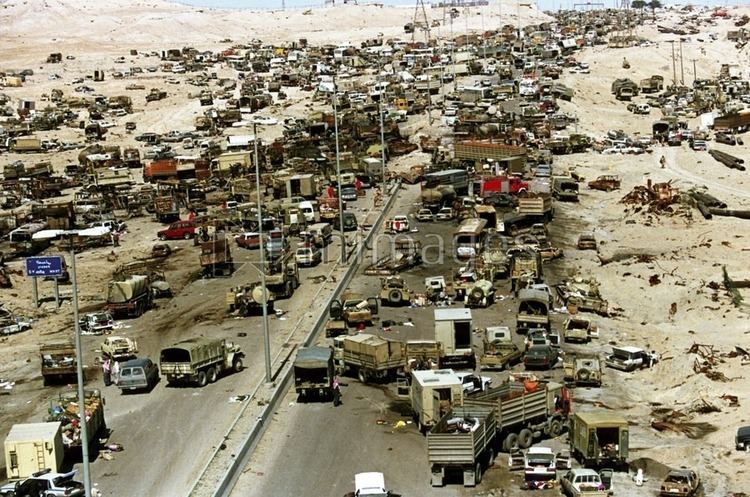 | ||
None Estimates range from ~200–300 to >10,000 killed and ~2,000 capturedEst. 1,800–2,700 vehicles Combatants Iraq, United States of America, Palestine Liberation Organization Similar Gulf War, Battle of Khafji, Liberation of Kuwait campaign, invasion of Kuwait, Gulf War air campaign | ||
highway of death iraqi army armed retreat from kuwait 1991
The Highway of Death (Arabic: طريق الموت ṭarīq al-mawt) refers to a six-lane highway between Kuwait and Iraq, officially known as Highway 80. It runs from Kuwait City to the border town of Safwan in Iraq and then on to the Iraqi city of Basra. The road had been used by Iraqi armored divisions for the 1990 Invasion of Kuwait. The road was repaired after the Persian Gulf War and used by U.S. and British forces in the initial stages of the 2003 invasion of Iraq.
Contents
- highway of death iraqi army armed retreat from kuwait 1991
- Desert storm 557th highway of death part iv
- Highway 80
- Highway 8
- Controversies
- In popular culture
- References

During the United Nations coalition offensive in the Persian Gulf War, American and Canadian aircraft and ground forces attacked retreating Iraqi military personnel attempting to leave Kuwait on the night of February 26–27, 1991, resulting in the destruction of hundreds of vehicles and the deaths of many of their occupants. U.S. attacks against the Iraqi columns were actually conducted on two different roads. Between 1,400 and 2,000 vehicles were hit or abandoned on the main Highway 80 north of Al Jahra (the "actual" Highway of Death). Several hundred more littered the lesser known Highway 8 to the major southern Iraq military stronghold of Basra.

The scenes of devastation on the road are some of the most recognizable images of the war, and it has been suggested that they were a factor in President George H. W. Bush's decision to declare a cessation of hostilities the next day. Many Iraqi forces, however, successfully escaped across the Euphrates river, and the U.S. Defense Intelligence Agency estimated that upwards of 70,000 to 80,000 troops from defeated divisions in Kuwait might have fled into Basra, evading capture.
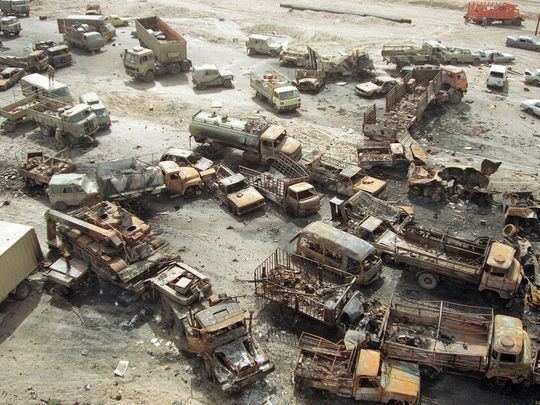
Desert storm 557th highway of death part iv
Highway 80
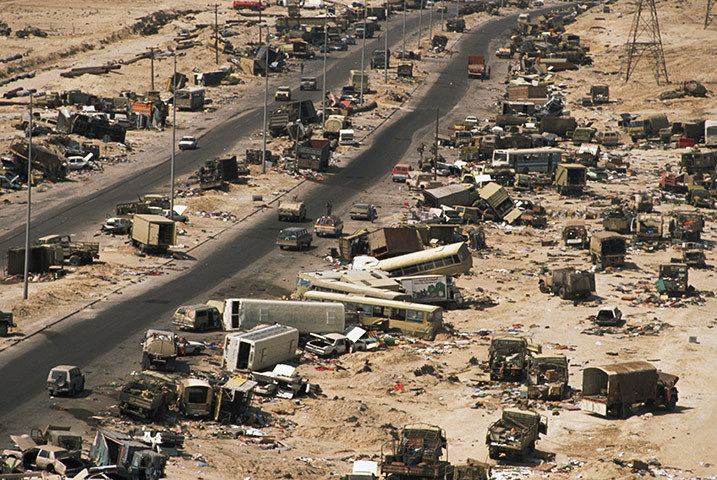
The 3rd Marine Aircraft Wing's A-6 Intruder aircraft blocked Highway 80, bombarding a massive vehicle column of mostly Iraqi Regular Army forces with Mk-20 Rockeye II cluster bombs, effectively boxing in the Iraqi forces in an enormous traffic jam of sitting targets for subsequent airstrikes. Over the next 10 hours, scores of U.S. Marine and U.S. Air Force aircraft and U.S. Navy pilots from USS Ranger (CV/CVA-61) attacked the convoy using a variety of ordnance. Vehicles surviving the air attacks were later engaged by arriving coalition ground units, while most of the vehicles that managed to evade the traffic jam and continued to drive on the road north were targeted individually. The road bottle-neck near the Mutla Ridge police station was reduced to a long uninterrupted line of more than 300 stuck and abandoned vehicles sometimes called the Mile of Death. The wreckage found on the highway consisted of at least 28 tanks and other armored vehicles with many more commandeered civilian cars and buses filled with stolen Kuwaiti property.
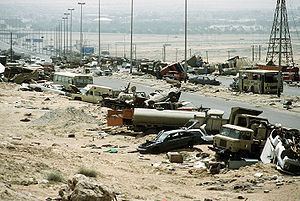
The death toll from the attack remains unknown and controversial. British journalist Robert Fisk said he "lost count of the Iraqi corpses crammed into the smouldering wreckage or slumped face down in the sand" at the main site and to see hundreds of corpses strewn up the road all the way to the Iraqi border. American journalist Bob Drogin reported seeing "scores" of dead soldiers "in and around the vehicles, mangled and bloated in the drifting desert sands." A 2003 study by the Project on Defense Alternatives (PDA) estimated fewer than 10,000 people rode in the cut-off main caravan; and when the bombing started most simply left their vehicles to escape through the desert or into the nearby swamps where some died from their wounds and some were later taken prisoner. According to PDA, the often repeated low estimate of the numbers killed in the attack is 200–300 reported by journalist Michael Kelly (who personally counted 37 bodies), but a minimum death toll of at least 500–600 seems more plausible.
In 1993, The Washington Post interviewed an Iraqi survivor of the attacks:
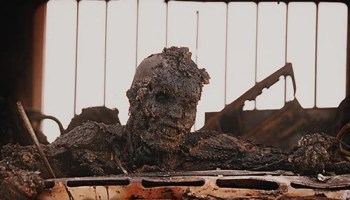
There were hundreds of cars destroyed, soldiers screaming. [...] It was nighttime as the bombs fell, lighting up charred cars, bodies on the side of the road and soldiers sprawled on the ground, hit by cluster bombs as they tried to escape from their vehicles. I saw hundreds of soldiers like this, but my main target was to reach Basra. We arrived on foot.
Highway 8
Iraqi forces including the elite Iraqi Republican Guard's 1st Armored Division Hammurabi were trying to either redeploy or escape on and near Highway 8 east of Highway 80. They were engaged over a much larger area in smaller groups by U.S. artillery units and a battalion of AH-64 Apache helicopter gunships operating under the command of General Barry McCaffrey. Hundreds of predominantly military Iraqi vehicles grouped in defensive formations of approximately a dozen vehicles were then systematically destroyed along a 50-mile stretch of the highway and nearby desert.
PDA estimated the number killed there to be in the range of 300-400 or more, bringing the likely total number of fatalities along both highways to at least 800 or 1,000. A large column composed of remnants of the Hammurabi Division attempting to withdraw to safety in Baghdad were also engaged and obliterated deep inside Iraqi territory by Gen. McCaffrey's forces a few days later on March 2 in a controversial post-war "turkey shoot"-style incident known as Battle of Rumaila.
Controversies
The offensive action for which Highway 80 is infamous became controversial with some commentators alleging disproportionate use of force, saying that the Iraqi forces were retreating from Kuwait in compliance with the original UN Resolution 660 of August 2, 1990; and the column allegedly included Kuwaiti hostages and civilian refugees. The alleged refugees included women and children family members of pro-Iraqi, PLO-aligned Palestinian militants and Kuwaiti collaborators who had fled shortly before the returning Kuwaiti authorities pressured nearly 200,000 Palestinians to leave Kuwait. Activist and former United States Attorney General Ramsey Clark alleged that these attacks violated the Third Geneva Convention, Common Article 3, which outlaws the killing of soldiers who "are out of combat." Clark included it in his 1991 report WAR CRIMES: A Report on United States War Crimes Against Iraq to the Commission of Inquiry for the International War Crimes Tribunal.
Additionally, journalist Seymour Hersh, citing American witnesses, alleged that a platoon of U.S. Bradley Fighting Vehicles from the 1st Brigade, 24th Infantry Division opened fire on a large group of more than 350 disarmed Iraqi soldiers who had surrendered at a makeshift military checkpoint after fleeing the devastation on Highway 8 on February 27, apparently hitting some or all of them. The U.S. Military Intelligence personnel who were manning the checkpoint claimed they too were fired on from the same vehicles and barely fled by car during the incident. Journalist Georgie Anne Geyer criticized Hersh's article, saying that he offered "no real proof at all that such charges—which were aired, investigated and then dismissed by the military after the war—are true."
Another, relatively minor, controversy regarded looting of functional Iraqi weapons after the battle, before the Military Police were deployed to guard the wreckage. Some scavenging Saudi civilians allegedly sold Iraqi assault rifles on the black market to buyers from the broader Middle East.
General Norman Schwarzkopf stated in 1995:
The first reason why we bombed the highway coming north out of Kuwait is because there was a great deal of military equipment on that highway, and I had given orders to all my commanders that I wanted every piece of Iraqi equipment that we possibly could destroy. Secondly, this was not a bunch of innocent people just trying to make their way back across the border to Iraq. This was a bunch of rapists, murderers and thugs who had raped and pillaged downtown Kuwait City and now were trying to get out of the country before they were caught.
Colin Powell, then Chairman of the Joint Chiefs of Staff and the future Secretary of State, said the "shooting gallery" scenes carnage was the reason to end the Persian Gulf War hostilities after the Liberation of Kuwait campaign. Powell wrote later in his autobiography My American Journey that "the television coverage was starting to make it look as if we were engaged in slaughter for slaughter's sake."
According to the Foreign Policy Research Institute, however, "appearances were deceiving":
Postwar studies found that most of the wrecks on the Basra roadway had been abandoned by Iraqis before being strafed and that actual enemy casualties were low. Further, opinion surveys showed that American support for the war was largely unaffected by the images. (Arab and Muslim public opinion was, of course, another matter, about which Powell may have been rightly concerned.)
Photojournalist Peter Turnley published photographs of mass burials at the scene. Turnley wrote:
I flew from my home in Paris to Riyadh when the ground war began and arrived at the “mile of death” very early in the morning on the day the war stopped. Few other journalists were there when I arrived at this incredible scene, with carnage that was strewn all over. On this mile stretch were cars and trucks with wheels still turning and radios still playing. Bodies were scattered along the road. Many have asked how many people died during the war with Iraq, and the question has never been well answered. That first morning, I saw and photographed a U.S. military “graves detail” burying many bodies in large graves. I don't recall seeing many television images of these human consequences. Nor do I remember many photographs of these casualties being published.
Time magazine commented:
The pictures were among the most stunning to come out of the gulf war: mile after mile of burned, smashed, shattered vehicles of every description—tanks, armored cars, trucks, autos, even stolen Kuwaiti fire trucks—littering the highway from Kuwait City to Basra. To some Americans, the pictures were also sickening. (...) After the war, correspondents did find some cars and trucks with burned bodies, but also many vehicles that had been abandoned. Their occupants had fled on foot, and the American planes often did not fire at them.
